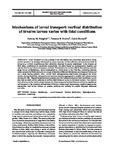Mechanisms of larval transport: vertical distribution of bivalve larvae varies with tidal conditions
| dc.contributor.author | Knights, Antony | |
| dc.contributor.author | Crowe, TP | |
| dc.contributor.author | Burnell, G | |
| dc.date.accessioned | 2018-08-13T12:36:31Z | |
| dc.date.available | 2018-08-13T12:36:31Z | |
| dc.date.issued | 2006-11-17 | |
| dc.identifier.issn | 0171-8630 | |
| dc.identifier.issn | 1616-1599 | |
| dc.identifier.uri | http://hdl.handle.net/10026.1/12044 | |
| dc.description.abstract |
Larval transport is a key process in the life-history and population dynamics of many marine species. It is strongly influenced by ocean currents, but the influence of behavioural traits of larvae (e.g. vertical migration) on their advective dispersal is poorly understood. In the absence of field data, predictions of population connectivity are often based on hydrodynamic models and assume that larvae behave as passive particles. Variations in the vertical distribution of early and late stage larvae of Mytilus spp. were investigated in a field study in the Irish Sea, collecting discrete water samples by Niskin sampler at a range of depths at different tidal states and phases at 2 sites and on 2 dates during summer 2005. Larvae were homogenously distributed throughout the water column during flood tide, whereas larvae we more densely aggregated in middle and bottom waters during ebb tide. Highest densities were greatest near the bottom during low flow conditions. Larval size had no effect on the patterns of vertical distribution of larvae in the water column. The relative lack of larvae in the water column during ebb tides compared to flood tides could lead to significant net transport in the direction of flood tides. If this is a widespread phenomenon, models based on the assumption that larvae behave as passive particles are unlikely to predict dispersal distances correctly. © Inter-Research 2006. | |
| dc.format.extent | 167-174 | |
| dc.language | en | |
| dc.language.iso | en | |
| dc.publisher | Inter-Research Science Center | |
| dc.subject | bivalve | |
| dc.subject | Mytilus spp. | |
| dc.subject | larval transport | |
| dc.subject | vertical distribution | |
| dc.subject | hydrodynamics | |
| dc.subject | behaviour | |
| dc.subject | modelling | |
| dc.title | Mechanisms of larval transport: vertical distribution of bivalve larvae varies with tidal conditions | |
| dc.type | journal-article | |
| dc.type | Article | |
| plymouth.author-url | https://www.webofscience.com/api/gateway?GWVersion=2&SrcApp=PARTNER_APP&SrcAuth=LinksAMR&KeyUT=WOS:000243104300014&DestLinkType=FullRecord&DestApp=ALL_WOS&UsrCustomerID=11bb513d99f797142bcfeffcc58ea008 | |
| plymouth.volume | 326 | |
| plymouth.publication-status | Published | |
| plymouth.journal | Marine Ecology Progress Series | |
| dc.identifier.doi | 10.3354/meps326167 | |
| plymouth.organisational-group | /Plymouth | |
| plymouth.organisational-group | /Plymouth/Faculty of Science and Engineering | |
| plymouth.organisational-group | /Plymouth/Faculty of Science and Engineering/School of Biological and Marine Sciences | |
| plymouth.organisational-group | /Plymouth/REF 2021 Researchers by UoA | |
| plymouth.organisational-group | /Plymouth/REF 2021 Researchers by UoA/UoA07 Earth Systems and Environmental Sciences | |
| plymouth.organisational-group | /Plymouth/Users by role | |
| plymouth.organisational-group | /Plymouth/Users by role/Academics | |
| plymouth.organisational-group | /Plymouth/Users by role/Researchers in ResearchFish submission | |
| dc.identifier.eissn | 1616-1599 | |
| dc.rights.embargoperiod | Not known | |
| rioxxterms.versionofrecord | 10.3354/meps326167 | |
| rioxxterms.licenseref.uri | http://www.rioxx.net/licenses/all-rights-reserved | |
| rioxxterms.type | Journal Article/Review |


